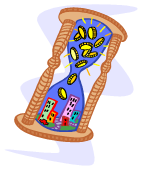Things to Consider for Operational Excellence
By Ted Margison – Excerpt from the book, Cracking the Business Code
[dropcaps type=”circle” color=”” background=””]T[/dropcaps]his section was going to be “8 Things to Consider for Operational Excellence”. The good news for you: there are only two things to consider.

Better Visibility Provides Better Results
A supplier of protective gear was struggling to meet demands. “We have tried everything over the past couple of years but nothing works. Our turns are less than 1 and we still can’t fill demand. We’ve been selling size 10 and 11 boots the last couple of years and now a customer needs size 13. No matter what we stock, it doesn’t seem to be the right thing; it’s like a guessing game.”
While I was in the General Manager’s office, he received a very angry call from the CEO of a very large customer. Without proper protective gear workers could not work – the downtime on one of their lines cost them about $100,000 per day.
 Obviously, the current decision-making processes were not effective; something was missing. We mapped the decision-making processes to find the “blind spots”. These are decision points that are not fully understood or assumptions have been made about them. The blind spots in this case were the decision-making processes of customers. In particular, what drives demand.
Obviously, the current decision-making processes were not effective; something was missing. We mapped the decision-making processes to find the “blind spots”. These are decision points that are not fully understood or assumptions have been made about them. The blind spots in this case were the decision-making processes of customers. In particular, what drives demand.
We interviewed the top 20 customers and found that demand was driven by two things: replacement of worn-out items and new hires. For replacement we realized that we could predict product life-expectancy based on job position and work environment characteristics. We proposed to the customers that we would gather and consolidate data across customers on job positions and work environment characteristics to predict life-expectancy and then automatically reach out to replace the items. For example, if a product had a life-expectancy of 36 months for workers in a particular department, we would do an inspection at 30 months and replace the item before it wore out. “New hire” demand was primarily “large scale” – new plants being opened, new mining projects. We identified a simple way of inserting ourselves in the hiring process to identify the best-fit product based on job position and work environment characteristics.
The customers were so excited about the recommendations that five of them offered, each, to pay half the cost of any system effort. Some offered the opportunity to bid on business that was going to competitors, while others simply switched their business from a competitor. As one customer said “We no longer have to worry about these decisions – you are making them for us. The cost of these products is far less than the cost of downtime; why would we talk to anyone else.”
Another company was about to make a strategic decision that would have serious operational impact. “We need to move to same-day shipping to get a competitive edge. Our customers buy when something breaks so we have to be able to respond quickly”, said the Sales Manager. The company had recently moved from 5-day turnaround on orders to 2 days and inventory had climbed to the point where turns hovered around 1.2. Moving to same-day shipping was going to be a major challenge.
In order to better understand the buying process for customers we interviewed the top 20 customers. Surprise: All could give at least three months notice on demand; one could give 12 months.
“Why do you give us only 2 days notice”, the CEO asked.
“Because that’s the lead time you gave Purchasing.”
We found some quick and easy ways to get this advance notice and in just a couple of months we were buying ‘to-order’ for these customers. We also approached supplier offering the advance notice. The VP Operations for the largest supplier (a company whose typical customer was 40 times our size) said “If you give us this advance notice you can order anything  you want up to end of the day on Friday and it will be on the truck Monday morning.”
you want up to end of the day on Friday and it will be on the truck Monday morning.”
In less than a year inventory turns reached 7.3. Shortly afterward, the company went on to acquire a larger company.
To get better visibility you need to go beyond your operations to include customers, business partners, suppliers and other external organizations. Start with processes that are key to achieving your business goals. Map your current processes (goes as far upstream and downstream as possible):
• Identify decision points
• Find the ‘blind spots’ for decision-making
- Who makes the decisions?
- What drives their decision-making?
— Triggers?
— What are they measured on (what’s a win for them)?
— Are they ‘driven’ by others in their org (interview those people)?
Accountability
For internal operations this is probably the single biggest problem for companies. Almost every company feels they have a good handle on accountability – unfortunately, they are usually wrong. When things aren’t performing effectively it’s usually because no one is accountable for the performance.
A manufacturing company was looking at getting a new ERP system. The CEO had heard horror stories from various customers and was concerned about implementation.
“What kinds of things go wrong during an implementation?” asked the CEO.
“Well, a major problem in many companies is that accountability is not well defined.”
“Oh, that’s not a problem here. We’re a very lean organization and everyone understands what they’re accountable for,” replied the CEO. “But, just out of interest, can you give me an example?”
“Well, although it might not apply here, companies that have problems with inventory often find that no one is responsible for inventory accuracy.”
“That’s not an issue for us. Dave, tell him who’s accountable for inventory accuracy.” said the CEO, nodding to his COO.
“No one,” replied the COO. “Maybe that’s why we have a $14 million inventory discrepancy.”
Effective accountability covers ownership, span of control, performance measurements and your reward/ recognition system.
Ted Margison is a Senior LCS Consultant and has over 30 years experience in operations management and process improvement. Ted worked for Ernst & Young in their manufacturing & distribution practice and then headed up one of PriceWaterhouse’s manufacturing & distribution practices on the west coast. You can contact Ted at ted@lighthouseconsulting.com or call him at 310-453-6556, ext. 422.
Permission is needed from Lighthouse Consulting Services, LLC to reproduce any portion provided in this article. © 2014
If you would like additional information on this topic or others, please contact your Human Resources department or Lighthouse Consulting Services LLC, 3130 Wilshire Blvd., Suite 550, Santa Monica, CA 90403, (310) 453-6556, dana@lighthouseconsulting.com & our website: www.lighthouseconsulting.com
Lighthouse Consulting Services, LLC provides a variety of services, including in-depth work style assessments for new hires & staff development, team building, interpersonal & communication training, career guidance & transition, conflict management, 360s, workshops, and executive & employee coaching. Other areas of expertise: Executive on boarding for success, leadership training for the 21st century, exploring global options for expanding your business, sales and customer service training and operational productivity improvement.
To order the books, “Cracking the Personality Code” and “Cracking the Business Code” please go to www.lighthouseconsulting.com.






Lighthouse provided me and my team with the information we often overlook while evaluating the actual operations of an organization. Lighthouse provided the most valuable tool in understanding the first of many of the operational aspects……the personalities of those involved. Without a firm understanding of the personalities of the personnel within your organization, you may never understand “why” the culture of the operation takes the shape it does.